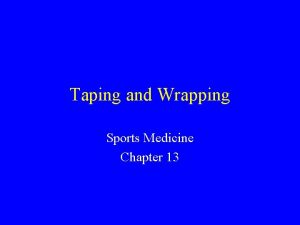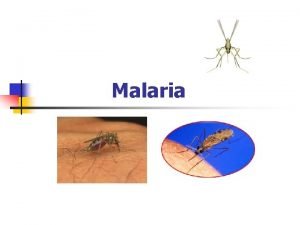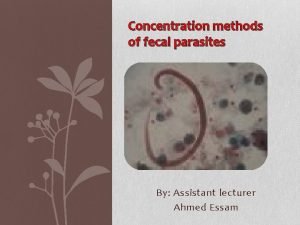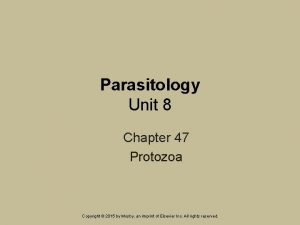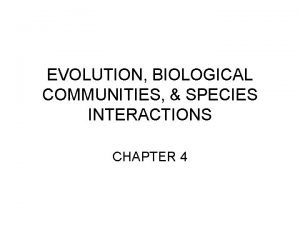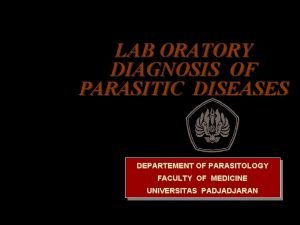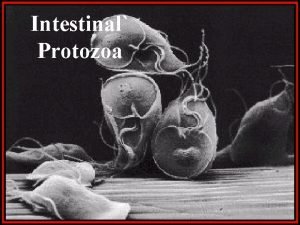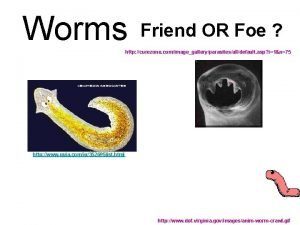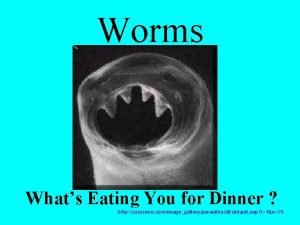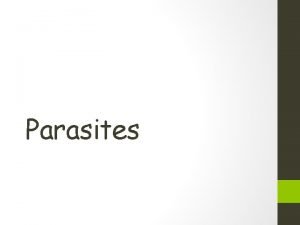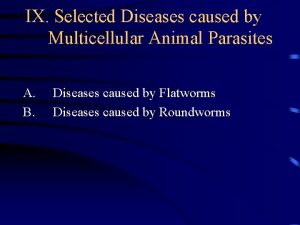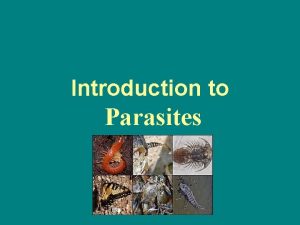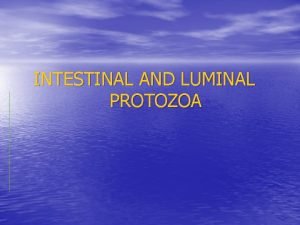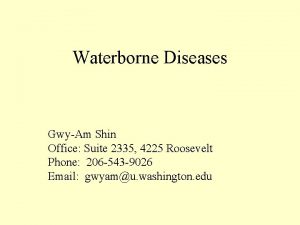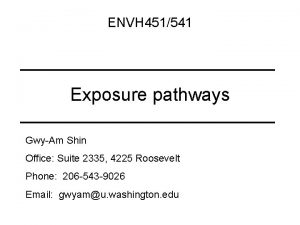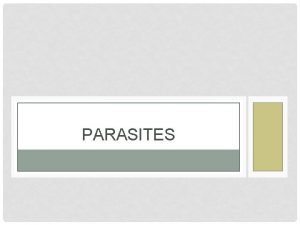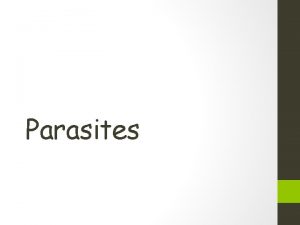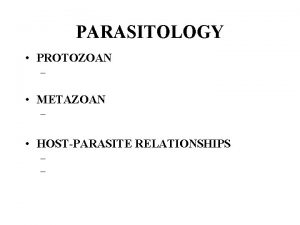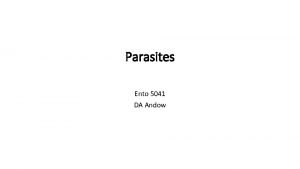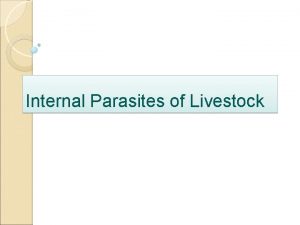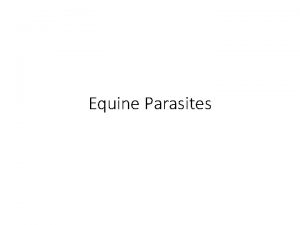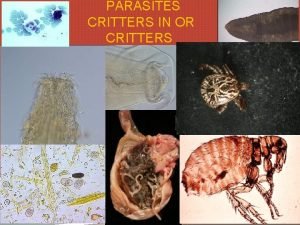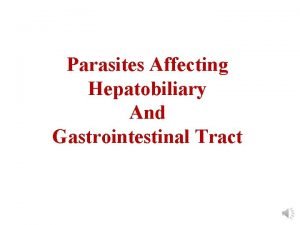Protozoan parasites GwyAm Shin Office Room 2335 4225



































- Slides: 35

Protozoan parasites Gwy-Am Shin Office: Room 2335, 4225 Roosevelt Way NE Phone: 206 -543 -9026 Email: gwyam@u. washington. edu

Pathogens in the environment • • • Viruses and prions Bacteria and rickettsiae Fungi and Algae Protozoans Helminths

Protozoa (Introduction) • Proto (=first) zoa (=animal) – Unicellular (one-celled) animals – > 50, 000 species (mostly free-living) • Protozoa vs. Humans – Normally not harmful – Inapparent or mild infections in normal individuals – Sometimes life-threatening infections in immunosuppressed people (e. g. AIDS patients) • Cryptosporidium parvum, Toxoplasma gondii, Microsporidia spp. (now fungi? ), and so on

Protozoa (structure I) • Size – Usually 10 -50 µm • smallest: 1 -10 µm, largest: ~150 µm (Balantidium coli) • Many organells – Nucleus (or nuclei) – Cytosome (cell mouth), food vacuoles, contractile vacuoles (osmoregulation), Golgi apparatus, mitochondria, lysosomes, … – Locomotive structures: pseudopodia, flagella, cilia • Cell cycle and reproduction – Asexual (binary fission) and sexual (various life stages)

Sizes of microorganisms

Structure of prokaryotic cells

Structure of eukaryotic cells

Protozoa (structure II)

Protozoa (structure III)

Protozoa (structure III)

Protozoa (classification I)

Entamoeba histolytica • Sarcomastigophora (Sarcodina) • Cyst – 10 -20 μm – 4 nuclei – 2 chromatoidal bars • Trophozoite – 12 -50 μm – 1 nucleus – actively mobile • Reproduction – binary fission of trophozoite – development of several (up to 4) trophozoites within the mature miltinucleated cyst.

Life cycle of Entamoeba histolytica

Epidemiology (Entamoeba histolytica) • Worldwide – 0. 5 % prevalence in developed countries – 10 -15 % (sometimes 50 -80 %) in developing countries • Most infections are inapparent (asymptomatic) – Still shed large number of cysts in their feces • Incubation period: 1 -4 weeks • Mild GI symptoms (abdominal pain, cramps, colitis and diarrhea), bloody diarrhea (amoebic dysentery) • High risk groups: travelers, recent immigrants, male homosexuals, institutioned populations

Epidemiology (Entamoeba histolytica) • Reservoir: human is the only host • Transmission: Direct transmission (sexually transmission), fecal-oral route, waterborne, foodborne • Prevention: adequate sanitation and excreta disposal, provision of non-fecally contaminated water and food

Giardia lamblia • Sarcomastigophora (Mastigophora) • Cyst – 8 -14 μm – 2 -4 nuclei – thick cyst wall (0. 3 μm) • Trophozoite – – Heart-shaped, symmetric 10 -18 μm long, 6 -8 μm wide 2 nuclei 8 flagellas • Reproduction – Binary fission of trophozoites

Life cycle of Giardia lamblia

Epidemiology (Giardia lamblia ) • Worldwide – 7. 2 % prevalence in USA • • Infectious dose: ~10 cysts Incubation period: 1 -14 days Duration of illness: 1 -3 weeks Symptoms: abdominal cramps, nausea, vomiting, anorexia, lowgrade fever, flu-like headache, general malaise, weakness, weight loss, distension, profuse, greasy, bulky and foul-smelling diarrhea • Fecal shedding: 103 -108 cysts/gram (human), 107 -108 cysts/gram (calves) • Levels in sewage: 3, 000 -30, 000 cysts/liter • High risk groups: children (in day-care centers), immunosuppressed people, and institutioned populations

Epidemiology (Giardia lamblia ) • Reservoir: Human and animals (dogs, beaver, muskrat, elk, deer, voles, mice, horses, sheep, …) • Transmission: Fomites, waterborne, foodborne • Prevention: personal hygiene, surface disinfection, water treatment, food safety program

Cryptosporidium parvum • Apicomplexa (Coccidia) • Oocyst – 4 - 6 m – 4 sporozoites – Thick oocyst wall • Sporozoite – No locomotive structure • Reproduction – Both asexual and sexual

Life cycle of Cryptosporidium parvum

Epidemiology (Cryptosporidium parvum) • Worldwide – 0. 3 % prevalence (general population) and 6 -54 % (day-care center children) in USA • • Infectious dose: < 10 oocysts Incubation period: 7 days Duration of illness: 1 -4 weeks Symptoms – Immunocompetent people: similar to giardiasis – Immunocompromised people: life-threating • Fluid loss: 2 -6 liters/day (17 liters/day) • Extra-intestinal infection: respiratory cryptosporidiosis (intestitial pneumonia) • Levels in sewage: 104 oocysts/liter • High risk groups: children, immunosuppressed people, institutioned populations

Epidemiology (Cryptosporidium parvum) • Reservoir: Human and animals (calves, lambs, goats, horses, pigs, deer, squirrel, beaver, muskrat, woodchuck, rabbit, dogs, fox, cat, skunk, raccon, bear, …) • Transmission: Fomites, waterborne, foodborne • Prevention: personal hygiene, surface disinfection, water treatment, food safety program

Balantidium coli • Ciliophora • Cyst – 50 -70 m – 2 nuclei – Various vacuoles • Trophozoite – 50 -100 m long, 40 -70 m wide – 2 nuclei – Many vacuoles – Locomotive method: cilia • Reproduction – Binary fission of trophozoites

Life cycle of Balantidium coli

Epidemiology (Balantidium coli) • Worldwide • Symptoms: mostly asymptomatic or similar to amebasis • Reservoirs: Human and animals (pigs, chimpanzees, …) • Transmission: waterborne, foodborne • Prevention: personal hygiene, water treatment, food safety program

Emerging Protozoan Parasites • Toxoplasma gondii • Microsporidia spp. (now fungi? )

Toxoplasma gondii (oocysts) • Apicomplexa (Coccidia) • Oocyst – Two phases • A: unsporulated • B: sporulated – – 10 – 13 m two sporocysts four sporozoites distinctive cell walls • two or three layers • scatter UV • highly persistent in the environment – soil (months) – moist conditions (years)

Toxoplasma gondii (other infectious forms) • Tachyzoite – – Crescent-shaped 2 X 6 m Rapidly multiflying Transmitted through placenta • Bradyzoite – Slowly multiplying – Tissues in intermediate hosts • Reproduction – Both asexual (intermediate hosts) and sexual (definitive hosts: cats)

Transmission of Toxoplasma gondii

Epidemiology (Toxoplasma gondii) • Worldwide – 22. 5 % prevalence (general population) in USA between 1988 -1994 – Half billion people in the world • Unusually high prevalence in France (65 -85%): raw or undercooked meat • High prevalence in Central America: large number of stray cats • Symptoms – Immunocompetent people: mostly asymptomatic, some flu-like symptoms (swollen lymph glands, muscle aches and pains) – Immunocompromised people: life-threating • central nerve system disease (encephalitis) • blindness, myocarditis, pneumonia – Congenital infected children • impaired vision and mental retardation • Fecal shedding: 105 oocysts/gram (cats) • High risk groups: infants born to infected mothers, immunosuppressed people

Microsporidia spp. • New Phylum – 143 genera, >1200 species – 14 identified human pathogens • Produce very resistant spores – Usuaually small (1 -4 m) • A unique organalle (polar tubule) – Coiled inside the spores – Inject infective spore contents into the host cells

Life cycle of Microsporidia spp.

Epidemiology (Microsporidia spp. ) • Worldwide – Both developed and developing countries • Symptoms: – Immunocompetent people: asymptomatic or self-limiting diarrhea – Immunocompromised people: • Chronic diarrhea • Disseminated diseases (keraconjunctivitis, bronchitis, pnuemonia, hepatitis, …) • Reservoirs: human and animals (rabbits, mice, dogs, pigs, cattle, wild birds (parrots), insects? ) • Transmission: uncertain – Airborne transmission? – Waterborne transmission? – Transplacental transmission? (Encephalitozoon spp. )

Other Protozoa • Trypanosomes- Sleeping Sickness – African (Tsetse flies) – American (kissing bugs) “Chaga’s” • • Acanthamoeba spp. (GAE) Balamuthia mandrillaris (GAE) Naeglaria fowlerii (PAM) Pneumocystis carinii (now P. jiroveci a fungus)
 - 5²+ 25 = ?
- 5²+ 25 = ? 4225-625
4225-625 Ba-room ba-room ba-room baripity
Ba-room ba-room ba-room baripity Reosnance
Reosnance Shin kubota
Shin kubota Shin splint tape wrap
Shin splint tape wrap Tel / tokyo electron sccm shin
Tel / tokyo electron sccm shin Parts of the head
Parts of the head Rikkwa floral arrangement
Rikkwa floral arrangement Tcm hospital malaysia
Tcm hospital malaysia Shin sobue
Shin sobue Turtle wexler character traits
Turtle wexler character traits Shin nakamura chemical
Shin nakamura chemical Nejime floral design
Nejime floral design Elizabeth shin mit
Elizabeth shin mit Kim shin jo
Kim shin jo Osi shin guards
Osi shin guards Is there a bathroom downstairs
Is there a bathroom downstairs To room nineteen characters
To room nineteen characters Hotel.hotelno=room.hotelno(hotel room)
Hotel.hotelno=room.hotelno(hotel room) What is ookinite
What is ookinite Ova cysts and parasites
Ova cysts and parasites Bacteria virus fungi and parasites
Bacteria virus fungi and parasites Sarcomastigophora are unicellular immotile parasites
Sarcomastigophora are unicellular immotile parasites What do parasites eat
What do parasites eat Parasites alimentaires
Parasites alimentaires Kato katz technique
Kato katz technique E histolytica cyst
E histolytica cyst Bankers are parasites
Bankers are parasites Curezone parasites
Curezone parasites Whats a tapeworm
Whats a tapeworm Parasites of livestock - vocabulary
Parasites of livestock - vocabulary How many herbivores are there
How many herbivores are there Multicellular animal parasites
Multicellular animal parasites Entamoeba histolytica common name
Entamoeba histolytica common name Luminal parasites
Luminal parasites





